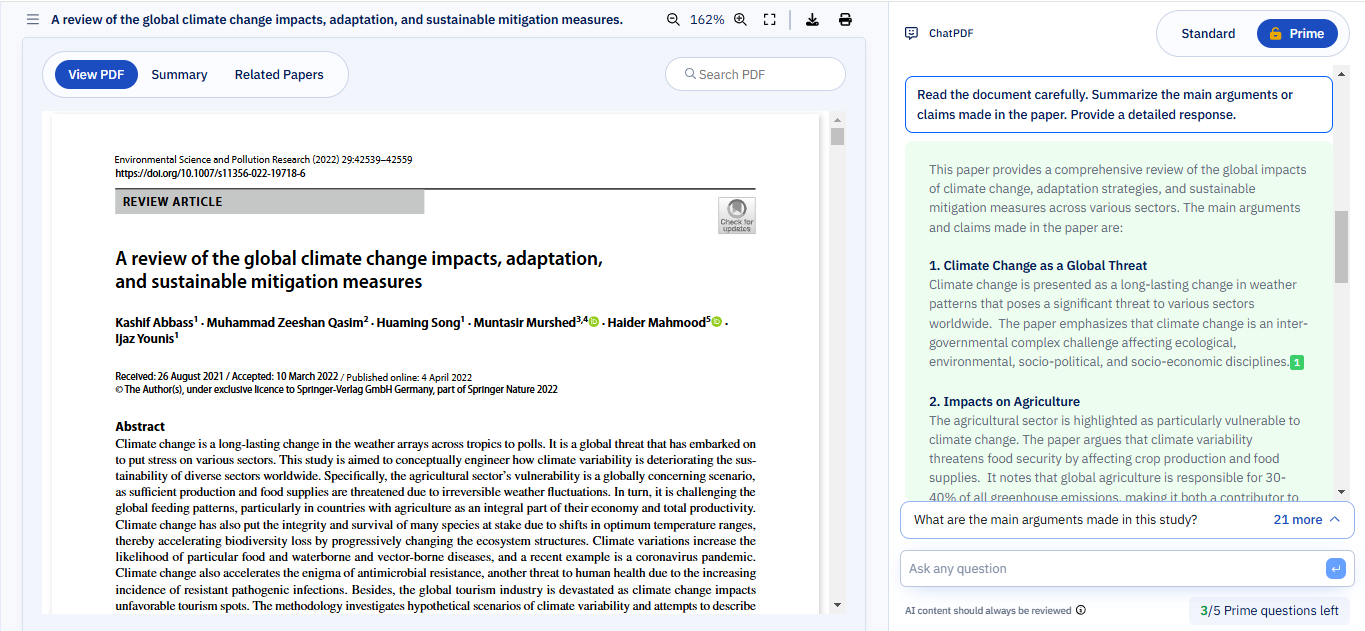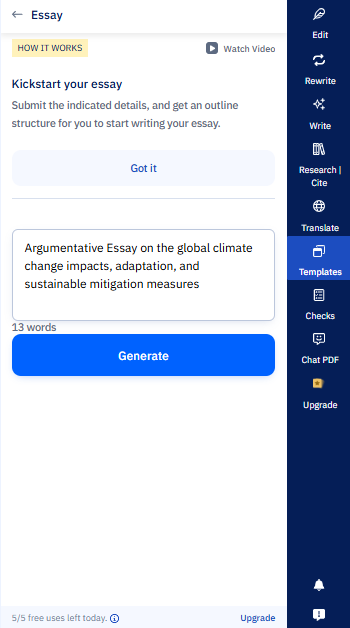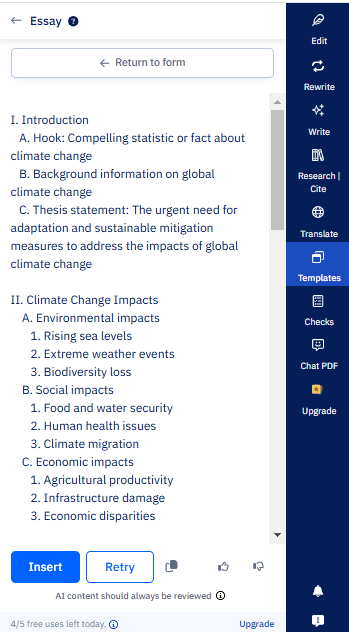Table of Contents
We define an argumentative essay as a type of essay that presents arguments about both sides of an issue. The purpose is to convince the reader to accept a particular viewpoint or action. When writing an argumentative essay, the writer takes a stance on a controversial or debatable topic and supports their position with evidence, reasoning, and examples. The essay should also address counterarguments, demonstrating a thorough understanding of the topic.
What is an argumentative essay?
An argumentative essay is a type of writing that presents a coherent and logical analysis of a specific topic.1 The goal is to convince the reader to accept the writer’s point of view or opinion on a particular issue. Here are the key elements of an argumentative essay:
- Thesis Statement: The central claim or argument that the essay aims to prove.
- Introduction: Provides background information and introduces the thesis statement.
- Body Paragraphs: Each paragraph addresses a specific aspect of the argument, presents evidence, and may include counter arguments.
- Evidence: Supports the main argument with relevant facts, examples, statistics, or expert opinions.
- Counterarguments: Anticipates and addresses opposing viewpoints to strengthen the overall argument.
- Conclusion: Summarizes the main points, reinforces the thesis, and may suggest implications or actions.
Argumentative essay structure
Aristotelian, Rogerian, and Toulmin are three distinct approaches to argumentative essay structures, each with its principles and methods.2 The choice depends on the purpose and nature of the topic. Here’s an overview of each type of argumentative essay format.
| Aristotelian (Classical) | Rogerian | Toulmin |
| Introduction: Introduce the topic. Provide background information. Present the thesis statement or main argument. |
Introduction: Introduce the issue. Provide background information. Establish a neutral and respectful tone. |
Introduction: Introduce the issue. Provide background information. Present the claim or thesis. |
| Narration: Provide context or background information. Set the stage for the argument. |
Contextualization: Describe opposing viewpoints without judgment. Show an understanding of the different perspectives. |
Claim: Clearly state the main argument or claim. |
| Confirmation: Present the main argument with supporting evidence. Use logical reasoning. Address counterarguments and refute them. |
Thesis and Common Ground: Present your thesis or main argument. Identify areas of common ground between opposing views. |
Data (Evidence): Provide evidence to support the claim. Include facts, examples, and statistics. |
| Refutation: Acknowledge opposing views. Provide counterarguments and evidence against them. |
Body: Present your arguments while acknowledging opposing views. Emphasize shared values or goals. Seek compromise and understanding. |
Warrant: Explain the reasoning that connects the evidence to the claim. Make the implicit assumptions explicit. |
| Conclusion: Summarize the main points. Reassert the thesis. End with a strong concluding statement. |
Conclusion: Summarize areas of agreement. Reiterate the importance of finding common ground. End on a positive note. |
Backing: Provide additional support for the warrant. Offer further justification for the reasoning. |
| Counterclaim: Address potential counterarguments. Provide evidence and reasoning to refute counterclaims. |
||
| Rebuttal: Respond to counterarguments and reinforce the original claim. |
||
| Conclusion: Summarize the main points. Reinforce the strength of the argument. |
Argumentative Essay Outline
An argumentative essay presents a specific claim or argument and supports it with evidence and reasoning. Here’s an outline for an argumentative essay, along with examples for each section:3
Introduction
- Hook: Start with a compelling statement, question, or anecdote to grab the reader’s attention. For example, “Did you know that plastic pollution is threatening marine life at an alarming rate?”
- Background information: Provide brief context about the issue. For example, “Plastic pollution has become a global environmental concern, with millions of tons of plastic waste entering our oceans yearly.”
- Thesis statement: Clearly state your main argument or position. For example, “We must take immediate action to reduce plastic usage and implement more sustainable alternatives to protect our marine ecosystem.”
Body Paragraphs
- Topic sentence: Introduce the main idea of each paragraph. For example, “The first step towards addressing the plastic pollution crisis is reducing single-use plastic consumption.”
- Evidence/Support: Provide evidence, facts, statistics, or examples that support your argument. For example, “Research shows that plastic straws alone contribute to millions of tons of plastic waste annually, and many marine animals suffer from ingestion or entanglement.”
- Counterargument/Refutation: Acknowledge and refute opposing viewpoints. For example, “Some argue that banning plastic straws is inconvenient for consumers, but the long-term environmental benefits far outweigh the temporary inconvenience.”
- Transition: Connect each paragraph to the next. For example, “Having addressed the issue of single-use plastics, the focus must now shift to promoting sustainable alternatives.”
Counterargument Paragraph
- Acknowledgement of opposing views: Recognize alternative perspectives on the issue. For example, “While some may argue that individual actions cannot significantly impact global plastic pollution, the cumulative effect of collective efforts must be considered.”
- Counterargument and rebuttal: Present and refute the main counterargument. For example, “However, individual actions, when multiplied across millions of people, can substantially reduce plastic waste. Small changes in behavior, such as using reusable bags and containers, can have a significant positive impact.”
Conclusion
- Restatement of thesis: Summarize your main argument. For example, “In conclusion, adopting sustainable practices and reducing single-use plastic is crucial for preserving our oceans and marine life.”
- Call to action: Encourage the reader to take specific steps or consider the argument’s implications. For example, “It is our responsibility to make environmentally conscious choices and advocate for policies that prioritize the health of our planet. By collectively embracing sustainable alternatives, we can contribute to a cleaner and healthier future.”
Create an Argumentative Essay Outline Faster with Paperpal
Here’s a step-by-step guide on how to use Paperpal to generate an outline for your argumentative essay
- Sign Up or Log In: Start by creating an account or logging into paperpal.com.
- Navigate to Paperpal Templates: Once logged in, proceed to the Templates section from the side navigation bar.
- Generate an essay outline: Under Templates, click on the ‘Outline‘ tab and choose ‘Essay’ from the options and provide your topic to generate an outline.
Types of Argument Claims Used in an Argumentative Essay
A claim is a statement or proposition a writer puts forward with evidence to persuade the reader.4 Here are some common types of argument claims, along with examples:
- Fact Claims: These claims assert that something is true or false and can often be verified through evidence.
Example: “Water boils at 100°C at sea level.” - Value Claims: Value claims express judgments about the worth or morality of something, often based on personal beliefs or societal values.
Example: “Organic farming is more ethical than conventional farming.” - Policy Claims: Policy claims propose a course of action or argue for a specific policy, law, or regulation change.
Example: “Schools should adopt a year-round education system to improve student learning outcomes.” - Cause and Effect Claims: These claims argue that one event or condition leads to another, establishing a cause-and-effect relationship.
Example: “Excessive use of social media is a leading cause of increased feelings of loneliness among young adults.” - Definition Claims: Definition claims assert the meaning or classification of a concept or term.
Example: “Artificial intelligence can be defined as machines exhibiting human-like cognitive functions.” - Comparative Claims: Comparative claims assert that one thing is better or worse than another in certain respects.
Example: “Online education is more cost-effective than traditional classroom learning.” - Evaluation Claims: Evaluation claims assess the quality, significance, or effectiveness of something based on specific criteria.
Example: “The new healthcare policy is more effective in providing affordable healthcare to all citizens.”
Understanding these argument claims can help writers construct more persuasive and well-supported arguments tailored to the specific nature of the claim.
How to Write an Argumentative Essay with Paperpal?
If you’re wondering how to start an argumentative essay, here’s a step-by-step guide to help you with the argumentative essay format and writing process using Paperpal.
Step 1: Choose a Topic
Select a topic that you are passionate about or interested in. Ensure that the topic is debatable and has two or more sides.
Step 2: Define Your Position
Clearly state your stance on the issue. Consider opposing viewpoints and be ready to counter them. To define your argumentative essay position, you can quickly upload PDFs on Paperpal and chat with it. You can interact with the PDF using the existing questions or ask your own to define the positioning statement. 
Step 3: Conduct Research
Gather relevant information from credible sources, such as books, articles, and academic journals. Take notes on key points and supporting evidence. For this, you can use Paperpal’s Research feature to search for relevant literature from 250Mn+ research papers and brainstorm on the arguments to explore.
Step 4: Create a Thesis Statement
Develop a concise and clear thesis statement that outlines your main argument. Convey your position on the issue and provide a roadmap for the essay.
Step 5: Outline Your Argumentative Essay
Organize your ideas logically by creating an outline with Paperpal Templates. Include an introduction, body paragraphs, and a conclusion. Each body paragraph should focus on a single point that supports your thesis. If you encounter any roadblocks, upload your rough notes on Paperpal Write or select from the pre-set AI prompts below to keep the writing momentum going. You can also draft your own prompt to get tailored results.
Step 6: Write the Introduction
Start with a hook to grab the reader’s attention (a quote, a question, a surprising fact). Provide background information on the topic. Present your thesis statement at the end of the introduction.
Step 7: Develop Body Paragraphs:
Begin each paragraph with a clear topic sentence that relates to the thesis. Support your points with evidence and examples. Address counterarguments and refute them to strengthen your position. Ensure smooth transitions between paragraphs.
Step 8: Address Counterarguments
Acknowledge and respond to opposing viewpoints. Anticipate objections and provide evidence to counter them.
Step 9: Write the Conclusion
Summarize the main points of your argumentative essay. Reinforce the significance of your argument. End with a call to action, a prediction, or a thought-provoking statement.
Step 10: Revise, Edit, and Share
Review your argumentative essay for clarity, coherence, and consistency. Check for grammatical and spelling errors, inconsistencies with Paperpal Grammar Checker and proofread your essay.
Step 11: Finalize Your Argumentative Essay
Once you’ve proofread your argumentative essay, run it through Paperpal AI Review to and get actionable feedback on the gaps in your writing. Make final edits based on feedback received and improve your argumentative essay before submitting it to your university. Additionally, you can also check your argumentative essay for plagiarism and pre-submission checks with Paperpal.
8 Tips to Write the Best Argumentative Essay
Here are eight strategies to craft a compelling argumentative essay:
- Choose a Clear and Controversial Topic: Select a topic that sparks debate and has opposing viewpoints. A clear and controversial issue provides a solid foundation for a strong argument.
- Conduct Thorough Research: Gather relevant information from reputable sources to support your argument. Use a variety of sources, such as academic journals, books, reputable websites, and expert opinions, to strengthen your position.
- Create a Strong Thesis Statement: Clearly articulate your main argument in a concise thesis statement. Your thesis should convey your stance on the issue and provide a roadmap for the reader to follow your argument.
- Develop a Logical Structure: Organize your essay with a clear introduction, body paragraphs, and conclusion. Each paragraph should focus on a specific point of evidence that contributes to your overall argument. Ensure a logical flow from one point to the next.
- Provide Strong Evidence: Support your claims with solid evidence. Use facts, statistics, examples, and expert opinions to support your arguments. Be sure to cite your sources appropriately to maintain credibility.
- Address Counterarguments: Acknowledge opposing viewpoints and counterarguments. Addressing and refuting alternative perspectives strengthens your essay and demonstrates a thorough understanding of the issue. Be mindful of maintaining a respectful tone even when discussing opposing views.
- Use Persuasive Language: Employ persuasive language to make your points effectively. Avoid emotional appeals without supporting evidence and strive for a respectful and professional tone.
- Craft a Compelling Conclusion: Summarize your main points, restate your thesis, and leave a lasting impression in your conclusion. Encourage readers to consider the implications of your argument and potentially take action.
Good argumentative essay example
Let’s consider a sample of argumentative essay on how social media enhances connectivity:
In the digital age, social media has emerged as a powerful tool that transcends geographical boundaries, connecting individuals from diverse backgrounds, and providing a platform for an array of voices to be heard. While critics argue that social media fosters division and amplifies negativity, it is essential to recognize the positive aspects of this digital revolution and how it enhances connectivity by providing a platform for diverse voices to flourish.
One of the primary benefits of social media is its ability to facilitate instant communication and connection across the globe. Platforms such as Facebook, Twitter, and Instagram break down geographical barriers, enabling people to establish and maintain relationships regardless of their physical location, fostering a sense of global community. Furthermore, social media has transformed the way people stay connected with friends and family. Whether separated by miles or time zones, social media ensures that relationships remain dynamic and relevant, contributing to a more interconnected world.
Moreover, social media has played a pivotal role in giving voice to social justice movements and marginalized communities. Movements such as #BlackLivesMatter, #MeToo, and #ClimateStrike have gained momentum through social media, providing a space for individuals to share their stories and advocate for change on a global scale. This digital activism has the power to shape public opinion and hold institutions accountable.
Social media platforms provide a dynamic space for open dialogue and discourse on a wide range of topics. Users can engage in discussions, share information, and challenge each other’s perspectives, fostering a culture of critical thinking. This open exchange of ideas contributes to a more informed and enlightened society, where individuals can broaden their horizons and develop a nuanced understanding of complex issues.
While criticisms of social media abound, it is crucial to recognize its positive impact on connectivity and the amplification of diverse voices. Social media transcends physical and cultural barriers, connecting people across the globe and providing a platform for marginalized voices to be heard. By fostering open dialogue and facilitating the exchange of ideas, social media contributes to a more interconnected and empowered society. Embracing the positive aspects of social media allows us to harness its potential for positive change and collective growth.
Argumentative essays require clear structure, strong evidence, and critical analysis to persuade readers effectively. By crafting a strong thesis, supporting claims with credible sources, and addressing counterarguments, writers can create compelling arguments. Integrating AI tools like Paperpal can further enhance this process by refining grammar, improving clarity, and suggesting stronger arguments, helping writers produce well-structured argumentative essays faster and more effectively.
Paperpal is a comprehensive AI writing toolkit that helps students and researchers achieve 2x the writing in half the time. It leverages 22+ years of STM experience and insights from millions of research articles to provide in-depth academic writing, language editing, and submission readiness support to help you write better, faster.
Get accurate academic translations, rewriting support, grammar checks, vocabulary suggestions, and generative AI assistance that delivers human precision at machine speed. Try for free or upgrade to Paperpal Prime starting at US$25 a month to access premium features, including consistency, plagiarism, and 30+ submission readiness checks to help you succeed.
Experience the future of academic writing – Sign up to Paperpal and start writing for free!








